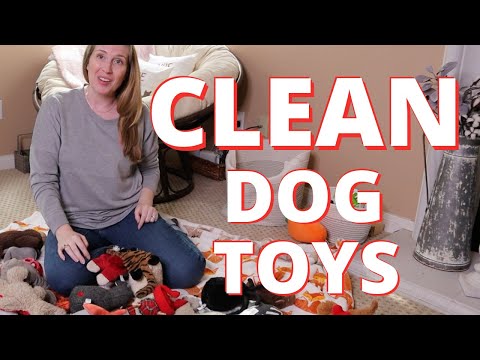Cleaning dog toys is crucial for keeping pets healthy and toys lasting longer. This guide makes it easy to clean dog toys with simple steps. It ensures toys are safe from germs and lasts longer. You’ll learn how to clean different types of toys, like rubber, plush, and squeaky ones, with easy tips.

Key Takeaways
- Clean toys regularly to reduce bacteria and odors.
- Use mild detergents to avoid damaging toys.
- Check for wear before cleaning to replace broken items.
- Follow material-specific methods for best results.
- Proper drying prevents mold and extends toy longevity.
Understanding the Importance of Cleaning Dog Toys
Cleaning your dog’s toys is more than just a task—it’s essential for their health. Germs and bacteria can spread fast on chewed or slobbered items. This turns favorite toys into potential dangers. Keeping them clean helps shield your pet from health problems.
Why Clean Dog Toys Matters
- Bacteria buildup on toys can cause stomach problems or infections.
- Dust or mold in fabric toys can make breathing issues worse for sensitive pets.
- Dirty toys lose their appeal quickly. Dogs might then chew on unsafe items instead.
Health and Safety Benefits
Studies reveal up to 70% of unwashed toys carry harmful microbes. Regular cleaning cuts down risks like Salmonella exposure or skin irritation. A clean toy also lasts longer, saving you money.
“Dirty toys are a top cause of minor pet illnesses we see in clinics,” says Dr. Emily Carter, a veterinary specialist. “A quick clean can prevent many visits.”
Think of it as preventive care. Cleaning toys is like brushing your dog’s teeth. It’s a small effort with big benefits for their health.
Preparing for a Successful Cleaning Session
Preparation is key. Before you start, make sure you have everything you need. You’ll want a mild pet-safe detergent, a soft brush, and a clean towel. Plastic, rubber, or plush toys each need different care, so sort them out first.
- Check toy tags for cleaning instructions.
- Inspect toys for cracks, stains, or loose parts.
- Separate damaged items for repair or disposal.
Before you clean, check for hidden problems. Look for trapped debris or smells that mean bacteria are present. Be careful with toys that have squeakers or ropes to avoid damage. Always check the labels—some materials can’t handle hot water or bleach.
“A quick check can save time and protect your pet’s favorite toy.”
Set up your cleaning area: a sink or tub is best. Keep cleaning products away from pets. Taking these steps ensures every toy gets safe, effective care. Ready? Next, we’ll walk through the actual cleaning steps.
how to clean dog toys: Step-by-Step Guide
Cleaning your dog’s toys is easier than you think. Follow these steps to protect your pet’s health and extend toy lifespan. Start with the basics and move through each phase carefully.
Gathering the Right Supplies
Begin with these essentials:
- Mild dish soap (like Dawn or Seventh Generation)
- Soft-bristle brushes or old toothbrushes
- White vinegar or pet-safe sanitizers
- Clean towels and a mesh laundry bag
Pre-Cleaning Inspection Tips
Check toys before washing:
- Inspect for cracks, loose parts, or mold
- Remove squeakers or stuffing if removable
- Sort toys by material (plastic, plush, rope)
Discard damaged toys immediately—safety comes first.
Safe Cleaning Practices
Clean toys using these methods:
- Soak toys in warm soapy water for 10 minutes
- Scrub stubborn stains with a brush
- Rinse thoroughly to remove soap residue
- Air-dry toys away from direct sunlight
Avoid bleach or hot water—they can degrade materials. Let toys dry fully before giving them back to your pet.
Cleaning Dog Toys in the Washing Machine
Machine washing is a quick way to clean dog toys. First, check the toy labels. Toys made of plastic, rubber, or nylon that are labeled as machine-safe are best. But, don’t wash plush toys with stuffing unless they say they’re washable.
Follow these steps for safe cleaning:
- Sort toys by material. Put small items in a mesh laundry bag to keep them from getting lost.
- Use a gentle cycle with cold water. Choose a mild detergent that doesn’t have harsh chemicals.
- Let toys air-dry completely. Don’t use high heat from a dryer, as it can melt plastics.

Pro tip: Add white vinegar to the rinse cycle to get rid of odors naturally. Don’t use fabric softener, as it can block pores in porous materials. Washing toys every 1–2 weeks keeps them clean and safe. Always check toys before and after washing—throw away any with loose parts or damage.
Cleaning Rubber Dog Toys Effectively
Rubber dog toys are tough, but they still need regular cleaning. This keeps them safe and fresh. Look for gentle products that won’t break down the material over time.
Choosing the right detergent is key. Avoid harsh chemicals like bleach or abrasive scrubbers:
- Use mild dish soap (like Dawn) or a pet-safe cleaner.
- Rinse thoroughly to remove all soap residue.
- Test new detergents on a small area first.
For best results, try these steps:
- Scrub toys with a soft brush to remove stuck-on dirt.
- Soak in warm, soapy water for 15–20 minutes.
- Air-dry completely—moisture trapped inside can lead to mold.
Regular cleaning keeps rubber toys safe and their lifespan. Skip the dishwasher or harsh scrubbers to avoid cracking or discoloration.
How to Clean Dog Toys with Squeakers
Dog toys with squeakers are fun but need special care. They can hide germs in their hidden parts. Cleaning them right keeps your dog happy and healthy. Here’s how to clean them without harming the squeaks.
Special Care for Squeaker Components
Always check the toy’s seams before cleaning. Look for any tears or loose parts. If you find any, it’s best to replace the toy to avoid choking hazards.
If the squeaker can be removed, like those from Chuckit! or KONG, take it out. This makes for a deeper clean.
Cleaning Without Damaging Mechanisms
- Fill a sink with warm water and a pet-safe detergent. Let the toy soak for 5–10 minutes.
- Use a soft brush to scrub around the squeaker. Be gentle to avoid damaging the mechanism.
- Rinse well and pat dry with a towel. Let it air-dry away from heat sources.
Pro tip: After drying, test the squeaker. If it’s not working, check for soap residue or if it’s out of place. If so, it’s time to replace it.
| Method | Steps | Time |
|---|---|---|
| Hand Wash | Soak, scrub gently, air-dry | 15–20 minutes |
| Machine Wash | Use a mesh laundry bag on gentle cycle; air-dry only | 30–40 minutes |
Cleaning Plush Dog Toys Safely
Plush toys need gentle care to stay soft and durable. Follow these tips to keep them clean and safe for your pet.
Hand Washing Versus Machine Washing
Choose the method that works best for your toy’s material:
| Method | Steps | Pros | Cons |
|---|---|---|---|
| Hand Washing | Soak in warm water with mild detergent, rinse thoroughly | Gentle on fabrics | Time-consuming |
| MACHINE WASHING | Use a delicate cycle in a mesh laundry bag | Quick and effective | Potential for pilling or stuffing shifts |
Drying and Maintenance Tips
After washing, follow these steps:
- Air-dry toys flat or in a shaded area.
- Never use heat dryers to avoid melting fabrics.
For long-term care:
- Check seams regularly for loose stitching.
- Spot clean stains immediately with a damp cloth.
Regular maintenance extends toy lifespan and keeps your pet’s favorite stuffed friends fresh.
Expert Tips for Cleaning Dog Rope Toys

Rope toys need special care to stay safe and last long. First, check the material to pick the best cleaning method. Natural fibers like cotton or hemp are gentle, while synthetic ropes can handle tougher cleaning.
Identifying Material Needs
Always check the care label first. For frayed ends, trim them carefully with scissors to avoid loose threads. Use a soft-bristled brush to clean between strands, avoiding harsh chemicals that can weaken the fibers.
- Cotton/hemp: Hand wash with mild soap
- Nylon/polyester: Machine washable on gentle cycle
- Colorful ropes: Check for dye bleeding before washing
Long-Term Maintenance Strategies
Make a maintenance routine to make toys last longer. After cleaning, let them air-dry away from direct sunlight. Check them weekly for wear and replace if strands become unsafe.
| Issue | Solution |
|---|---|
| Mildew smell | Soak in vinegar-water mix |
| Embedded dirt | Use baking soda paste |
| Matted fibers | Untangle while damp |
Regular care keeps rope toys clean and working well. Store them in a cool, dry place between uses to prevent bacteria growth. Always throw away damaged toys to keep your dog safe.
Conclusion
Keeping dog toys clean is key for your pet’s health and the toys’ life. You can wash them in a machine or by hand. This stops bacteria and makes toys last longer.
It’s important to know how to clean different types of toys. This keeps playtime safe and clean. Always check toys for damage before cleaning to avoid risks.
Choosing the right detergent and drying method keeps toys fresh. Brands like KONG and Nylabone say cleaning is important for safety. Regular cleaning and gentle scrubbing for squeakers stop mold and germs.
Creating a cleaning routine makes toys safe and fun. Store clean toys in dry places to avoid moisture. By following these steps, you make a safe play area for your pet. Small steps today mean happier pets and fewer new toys needed. Happy cleaning!



